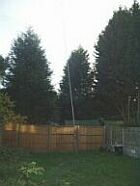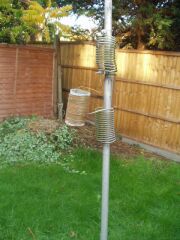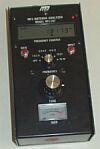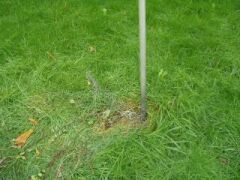
Background
Quite a few years ago I operated on Top Band from a different location near to Bracknell which offered sufficient space for a decent antenna on that band. With the 10W which we were allowed in those days I managed to work quite a lot of DX and even managed a QSO with ZL3GQ in New Zealand (recording). The Top Band bug had bit! But when I moved to my present QTH in 1977 my garden had shrunk somewhat and the potential for even local contacts on the band had diminished. Coupled with that, the ground in the area is largely sand, which has high earth resistance and is not favourable for producing efficient antennas for the lower bands. What to do to get me going on my favourite band?
I had for some time been using my Butternut HF2V on 40m, and it worked well on that band. It did not work so well on 80m as I could never seem to get it to match properly at the CW end of the band, an indication that I had a very high ground resistance due to my poor earth. It was some time before I purchased my K2 (and was still using an FT101ZD at around 100W) that I started to think about re-resonating it for Top Band.
Construction
I decided to add extra inductance in series with the existing loading coils, and also to remove the 40m coupling capacitor and bracket. This meant in effect that it would now be a single band, Top Band antenna.

I had an old loading coil that I had previously used with a seperate Top Band vertical, so I decided to add this to the loading coil sections of the Butternut. A little playing about was needed to get the correct inductance, but it eventually matched and results were good - I managed to QSO a W9 on QRO, not bad.
The general construction is shown in the photo at the right, with the new coil simply supported between the existing coil fixing screws. I do not claim to any originality in the design, and certainly not in its construction which is very much Heath Robinson! Setting the antenna to resonance is made much easier with the use of an MFJ or similar antenna analyser - the MFJ247 is shown, which was used recently to recheck the resonance.
Performance
After a while I operated less and less on the HF bands and Butternut got used very little. Eventually I bought my K2 and operating with QRP I again got interested in Top Band. But with 5W it was a real struggle to make contacts. I tried both my longwire and the Butternut, but neither seemed to be getting out. I did manage quite a few contacts during the major international contests, but each one was a real struggle.

It was only much later that I had chance to borrow an MFJ analyser and check the antenna for its impedance and resonance. It was quickly found that it actually resonated at 2.1MHz! Once correctly resonated, the SWR at the base was found to be 2:1, implying an impedance of around 100 ohms. Since the input impedance of a base loaded vertical should be only a few ohms, this was not a good sign! However a reel of chicken wire which happened to be laying in the garden was joined to the earthy side of the antenna, and this brought the SWR down to 1:1, rather better, but it still implied the earth resistance was 50 ohms and most of my power would be dissipated there rather than being radiated.

Incidentally a useful program for designing and checking the performance of vertical antennas is VERTLOAD which can be found on the late Reg G4FGQ's site, along with various other programs of interest to the radio amateur.
Once resonated and properly matched the vertical now seems to be performing rather better. Of course I would like to reduce the earth resistance quite a lot more, but that is going to be difficult in my small plot and poor ground. But there does seem to be hope for Top Band from the smaller plot.